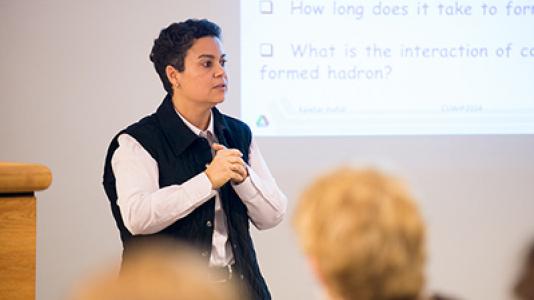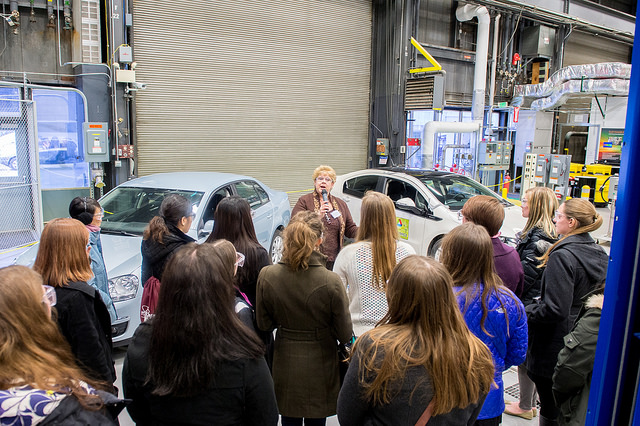
Eighty-five undergraduate women in the physics field toured Argonne National Laboratory on January 17 as part of the 2014 Midwest Conference for Undergraduate Women in Physics.
“It’s a great opportunity to encourage and help prepare young women in the field of physics,” said Argonne Physicist Kawtar Hafidi. “Touring Argonne’s cutting-edge research facilities gives these women some insight into what they can look forward to as they continue to pursue their dream of becoming scientists and innovators. It’s also a good way for them to learn about future internship and career opportunities that Argonne offers.”
The participants visited the lab’s Advanced Photon Source (APS), Argonne Tandem Linac Accelerator System (ATLAS) facility, the Nuclear Energy exhibit and the Transportation Technology R&D Center, among other areas of the laboratory.
Established in 1946, Argonne is the first national laboratory in the United States and continues its tradition of excellence as a world-class destination for scientists and engineers. The APS, for instance, provides the brightest X-ray beams in the Western Hemisphere to more than 5,000 scientists worldwide each year.
Maria Goeppert Mayer, one of only two women to win the Nobel Prize in physics — the first was Marie Curie — did her Nobel Prize winning research at Argonne’s ATLAS facility, one of the stops on the tour.
Argonne Laboratory Director Eric Isaacs, also a physicist, welcomed the women to the laboratory. “As undergraduates, you are just beginning your incredible journey. As you are here today, I want you to see all the possibilities and imagine the future. I want you to see yourselves as scientists and realize you have the power to change the world, just as the scientists before you,” said Isaacs.
“Diversity of thought is crucial to scientific excellence and new discoveries,” Isaacs went on to say. “We need multiple viewpoints to develop the most innovative and workable solutions to our nation’s biggest challenges in energy, the environment and national security. You, your creativity and drive are key to our success in discovery and innovation. We need you. We need more of you.”
The 2014 Midwest Conference for Undergraduate Women in Physics, held at University of Chicago, was a four-day regional conference aimed at providing female undergraduate students with information and resources to support them as they pursue a career in physics. Activities included talks by women physicists, student poster sessions, and workshops and panel discussions and opportunities for professional networking and informal mentoring. Topics of discussions included summer research, graduate school, physics careers and professional development. Participants were invited to tour either Argonne National Laboratory or Fermilab National Accelerator Laboratory.
“We need more women in physics — in all the STEM [science, technology, engineering and mathematics] career fields, for that matter,” said Hafidi. “As a physicist, I’ve participated in this conference in the hope that I and my colleagues will inspire more young women to pursue careers within the field. Only a small percentage of the U.S. population will choose a career in physics, and within that subgroup, only a fraction are women. So what’s the reason for this statistical inequality? There are quite a few factors, but one is opportunity. This conference is one way in which we’re working to provide women with opportunities, encouragement and information so they can succeed.”
The American Physical Society hosts annual Conferences for Undergraduate Women in Physics in eight regional locations, nationwide.
